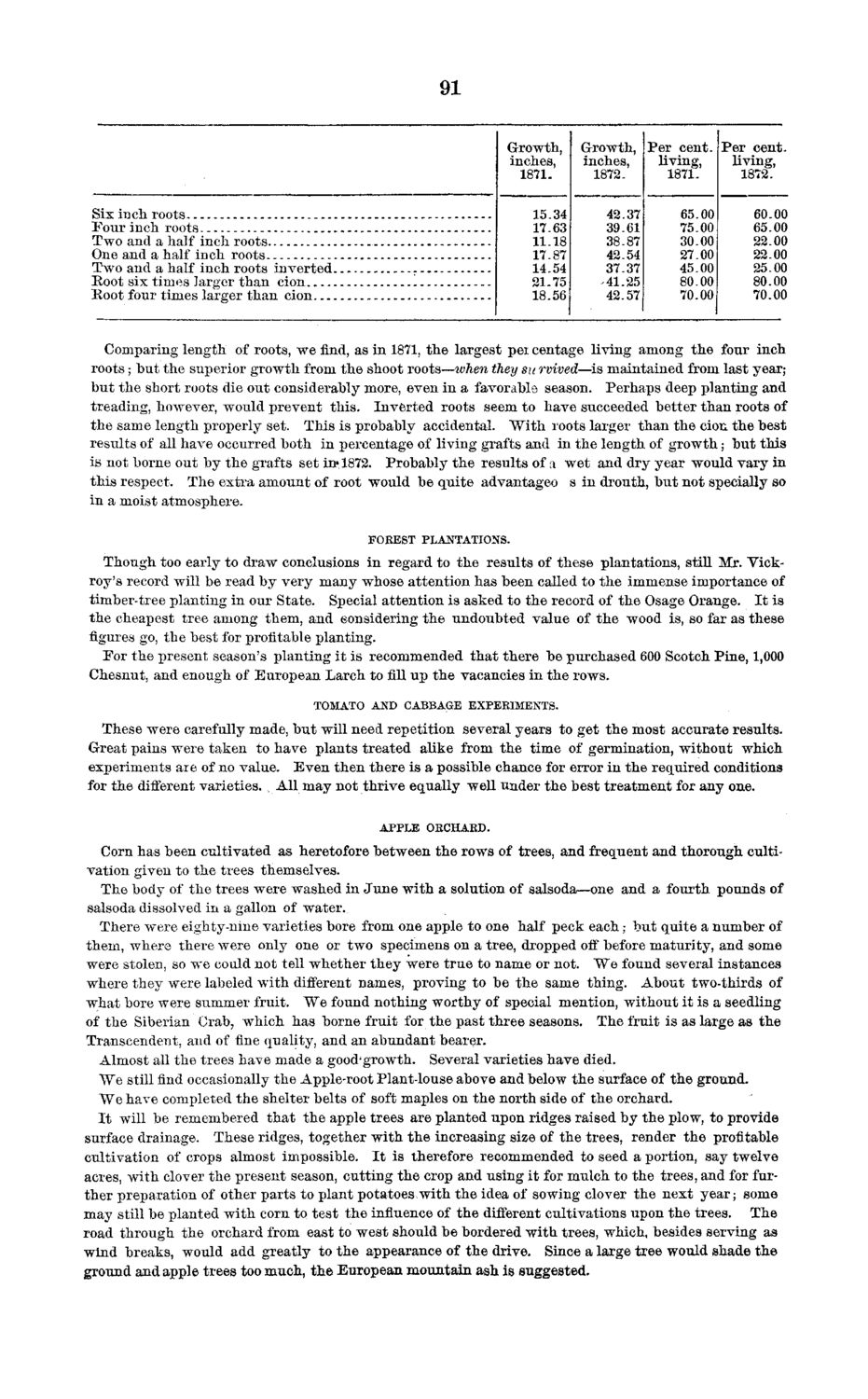| |
| |
Caption: Board of Trustees Minutes - 1873
This is a reduced-resolution page image for fast online browsing.

EXTRACTED TEXT FROM PAGE:
91 Growth, inches, 1871. Six inch roots Pour inch roots Two and a half inch roots One and a half inch roots Two and a half inch roots inverted, Root six times larger than cion Root four times larger than cion— 15.34 17.63 11.18 17.87 14.54 21.75 18.56 Growth, Per cent, Per cent, inches, living, living, 1871. 1872. 1872. 42.37 39.61 38.87 42.54 37.37 41.25 42.57 65.00 75.00 30.00 27.00 45.00 80.00 70.00 60.00 65.00 22.00 22.00 25.00 80.00 70.00 Comparing length of roots, we find, as in 1871, the largest per centage living among the four inch roots; but the superior growth from the shoot roots—when they survived—is maintained from last year; but the short roots die out considerably more, even in a favorable season. Perhaps deep planting and treading, however, would prevent this. Inverted roots seem to have succeeded better than roots of the same length properly set. This is probably accidental. With roots larger than the cion the best results of all have occurred both in percentage of living grafts and in the length of growth; but this is not borne out by the grafts set in* 1872. Probably the results of a wet and dry year would vary in this respect. The extra amount of root would be quite advantageo s in drouth, but not specially so in a moist atmosphere. FOREST PLANTATIONS. Though too early to draw conclusions in regard to the results of these plantations, still Mr. Vickroy's record will be read by very many whose attention has been called to the immense importance of timber-tree planting in our State. Special attention is asked to the record of the Osage Orange. I t is the cheapest tree among them, and considering the undoubted value of the wood is, so far as these figures go, the best for profitable planting. For the present season's planting it is recommended that there be purchased 600 Scotch Pine, 1,000 Chesnut, and enough of European Larch to fill up the vacancies in the rows. TOMATO AND CABBAGE EXPERIMENTS. These were carefully made, but will need repetition several years to get the most accurate results. Great pains were taken to have plants treated alike from the time of germination, without which experiments are of no value. Even then there is a possible chance for error in the required conditions for the different varieties. . All may not thrive equally well under the best treatment for any one. APPLE ORCHARD. Corn has been cultivated as heretofore between the rows of trees, and frequent and thorough cultivation given to the trees themselves. The body of the trees were washed in June with a solution of salsoda—one and a fourth pounds of salsoda dissolved in a gallon of water. There were eighty-nine varieties bore from one apple to one half peck each; but quite a number of them, where there were only one or two specimens on a tree, dropped off before maturity, and some were stolen, so we could not tell whether they were true to name or not. We found several instances where they were labeled with different names, proving to be the same thing. About two-thirds of what bore were summer fruit. We found nothing worthy of special mention, without it is a seedling of the Siberian Crab, which has borne fruit for the past three seasons. The fruit is as large as the Transcendent, and of fine quality, and an abundant bearer. Almost all the trees have made a good'growth. Several varieties have died. We still find occasionally the Apple-root Plant-louse above and below the surface of the ground. We have completed the shelter belts of soft maples on the north side of the orchard. I t will be remembered that the apple trees are planted upon ridges raised by the plow, to provide surface drainage. These ridges, together with the increasing size of the trees, render the profitable cultivation of crops almost impossible. I t is therefore recommended to seed a portion, say twelve acres, with clover the present season, cutting the crop and using it for mulch to the trees, and for further preparation of other parts to plant potatoes with the idea of sowing clover the next year; some may still be planted with corn to test the influence of the different cultivations upon the trees. The road through the orchard from east to west should be bordered with trees, which, besides serving as wind breaks, would add greatly to the appearance of the drive. Since a large tree would shade the ground and apple trees too much, the European mountain ash is suggested.
| |